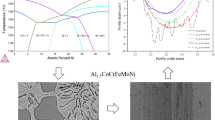Abstract
This paper presents the results of a study of the effect of matrix yield strength, at constant Widmanstätten α microstructure, on the fracture resistance of an α-β Ti alloy, CORONA-5. Fracture initiation resistance,J q, and the stable crack growth resistance,T, were evaluated by the single specimen, unloading compliance method for four different microstructures and three yield strengths. The microstructures involved coarse or fine Widmanstätten α particles in a heat treated β-matrix; the yield strength ranged from 765 to 1018 MPa. It was found thatJ q/σY, where σY is the effective yield strength, decreased with increasingσ Y.T/σ Y also decreased with increasing σY for fine structures. For the coarse α structures, however, T/σY revealed intermediate maxima. Coarser structures, in general, revealed higher values ofJ q/σY andT/σ Y. The cause was found primarily to be due to the effect of increased α particle thickness. The effect of grain size was secondary. Jq/σY increased with increasing tensile strain hardening rate, obtained at the onset of void nucleation. T/σY was found to decrease with increasing tensile void growth rate. In general, Jq/σY and T/σY revealed different relationships with microstructure. Fatigue precrack front- and the stable crack length-tortuosities did not yield any general relationship to fracture resistance at different yield strengths.
Similar content being viewed by others
References
M. A. Greenfield and H. Margolin:Metall. Trans., 1971, vol. 2, pp. 841–47.
H. Margolin, M. A. Greenfield, and I. Greenhut:Titanium Science and Technology, Plenum Press, 1973, vol. 3, pp. 1709–18.
J. C. Chesnutt, C. G. Rhodes, and J. C. Williams:Fractography- Microscopic Cracking Processes, ASTM STP 600, 1976, pp. 99–138.
J.P. Hirth and F.H. Froes:Metall. Trans. A, 1977, vol. 8A, pp. 1165–76.
P.W. Early and S.J. Bums:Scripta Metall., 1977, vol. 11, pp. 867–69.
K.-H. Schwalbe:Engg. Frac. Mech., 1977, vol. 9, pp. 795–832.
J. C. Williams, F. H. Froes, J. C. Chesnutt, C. G. Rhodes, and R. G. Berryman:Toughness and Fracture Behavior of Titanium, ASTM STP 651, 1978, pp. 64–114.
W. J. Oberparleiter:Proc. of the 4th European Conference on Fracture, Leoben, Austria, Sept. 22-24, 1982, pp. 110–17.
H.W. Rosenberg, J. C. Chesnutt, and H. Margolin:Application of Fracture Mechanics for Selection of Metallic Structural Materials, ASM, Metals Park, OH, 1982, pp. 213–52.
A. Gysler and G. Liitjering:Titanium Science and Technology, Deutsche Gesellschaft für Metallkunde E.V., 1984, vol. 3, pp. 2001–08.
C.G. Rhodes:Titanium Science and Technology, Deutsche Gesellschaft für Metallkunde E.V., 1984, vol. 3, pp. 2009–14.
H. Wei, G. Liu, and Z. Lai:Titanium Science and Technology, Deutsche Gesellschaft für Metallkunde E.V., 1984, vol. 3, pp. 2015–21.
S. Suresh and A.K. Vasudévan:Mater. Sci. Engg., 1986, vol. 79, pp. 183–90.
R. O. Ritchie and A. W. Thompson:Metall. Trans. A, 1985, vol. 16A, pp. 233–48.
G. A. Clarke, W.R. Andrews, P.C. Paris, and D.W. Schmidt:Mechanics of Crack Growth, ASTM STP 590, 1976, pp. 27–42.
ASTM STD 813-81,Annual Book of ASTM Standards, ASTM.
D. Jablonski:Automated Test Methods for Fracture and Fatigue Crack Growth, ASTM STP 877, 1985, pp. 269–97.
Y.H. Jung, K.R. Narendrnath, P.S. Godavarti, and K.L. Murty:Engg. Frac. Mech., in press.
H. Margolin and T. V. Vijayaraghavan:Metall. Trans. A, 1983, vol. 14A, pp. 2043–53.
H. Margolin:Metall. Trans. A, 1982, vol. 13A, pp. 2191–95.
K. R. Narendrnath and H. Margolin:Metall. Trans. A, 1988, vol. 19A, pp. 1163–71.
M.A. Greenfield and H. Margolin:Metall. Trans., 1972, vol. 3, pp. 2649–59.
Author information
Authors and Affiliations
Rights and permissions
About this article
Cite this article
Narendrnath, K.R., Margolin, H. The effect of matrix strength on the fracture resistance of an alpha-Beta titanium alloy, corona-5. Metall Trans A 19, 2503–2512 (1988). https://doi.org/10.1007/BF02645478
Received:
Issue Date:
DOI: https://doi.org/10.1007/BF02645478




